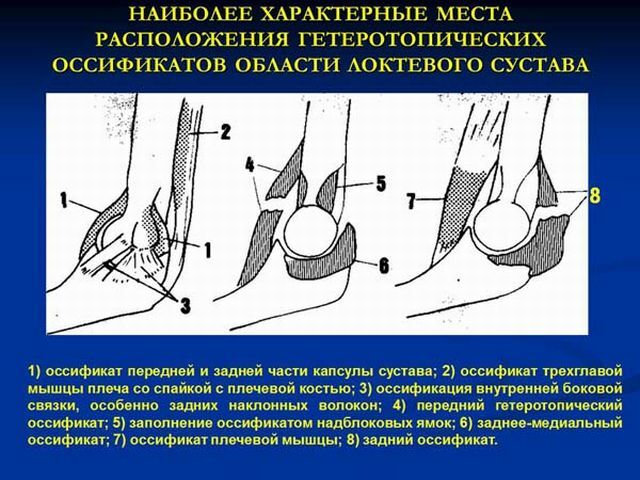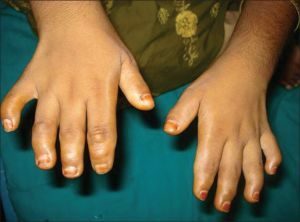 The human body has one important and unique feature. This is the ability to walk on the ground straight up to the full height on two legs.
The human body has one important and unique feature. This is the ability to walk on the ground straight up to the full height on two legs.
This feature allows a person to stand out in the living world of the spine - the spine. On how healthy this part of the skeleton is, a lot depends.
Its structure, bone-ligament elements - all this allows the ridge to be stable and "carry" us on the ground.
For example, existing problems in the lumbar region of the ridge lead to lumbar pain.
The presence of cracks between the joints of the spine will already cause the disease of spondylolysis. Most often, it refers to the fifth leg of the lumbar arch or so-called spondylolysis l5.
This disease leads to a delay in the development of the spine. What is Spinal Disease Spondylolisthesis?
In the presence of such a defect on both sides, the ridge may slip forward . This disease is more serious and is called Spondylolisthesis.
The most common spondylolisthesis of the cervical spine.
To date, this disease occurs in 6% of the world's population. At a young age, the number of patients among women and men is identical.
But already at an older age, after about 20 years, this disease is more common in men.
Article Contents
- reasons
- disease What happens to own joint
- pathology classification
- Degrees pathology
- Types
- Location
- As manifested disease
- Diagnostics
- disease Treatment - objectives and methodology
- Goals and
- tasks Conservative
- Surgery
- Complications
- Preventive measures
Causes of the disease
In the modern world, such a disease as spondylolysis of the spine is most common in athletes.
Since constant single-type loads lead to the so-called "melting" of the connecting link - the interarticular part of the spine. Similarly, "melting" in the case of an irreparable violation is called a "fracture of fatigue".
What happens to the joint
First, this part of the joint is the connecting link between the joints of the whole ridge and it provides flexibility to the human body. The greater the load, 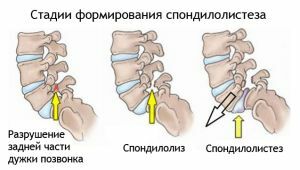 , especially in training for athletes, the greater the likelihood of this disease.
, especially in training for athletes, the greater the likelihood of this disease.
What is unbelievable is that for quite a long time the body independently restores interarticular tissues preventing damage, but with constant exposure, attempts of the organism become weaker and "break".
This is not a congenital disease, but in children it occurs at a fairly early age. It is for this reason that spondylolysis, in these cases, is usually called an innate condition.
But in the case of children this disease has no complications, since children do not lead an intensive life, which involves working with heavy objects.
Classification of the pathology of
Our body, namely the spine, is designed in such a way that the main burden in the transfer of weights falls on the lumbar spine. It is for this reason that the disease concerns a separate part of it( the fifth and rarely the fourth lumbar vertebrae).
Basically, the classification depends on the type of displacement, that is, the direction in which the joint has shifted:
- Antenesponilysthesis is formed when the vertebrae of the upper vertex are shifted or "slipped", as if pushing forward. This variant of displacement is also called "anterior".
- Retrospondylolisthesis means the same, but here the bias is "behind".
- Late-spondylolisthesis, a more serious variant of spondylolysis, when the displacement occurs in the lateral plane.
For the most part, all types of bias can lead to complications of a clinical nature. This is due to the fact that the nerve is jammed, which leads to undesirable consequences.
Degrees of pathology
The following degrees of bias are distinguished:
- First degree. Indicated if the displacement occurred on a quarter of the plate.
- Second degree - half.
- The third degree is on the third plate.
- Fourth degree - if the plate has moved more than a third.
Degrees of bias can be seen by making an x-ray on the side.
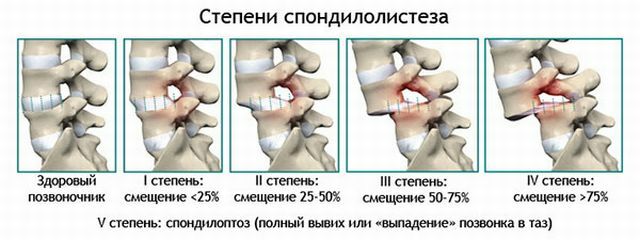
Species
The types of this disease depend on:
- the causes of the onset of the disease, including the physical characteristics of the origin of spondylolysis;
- physical displacement characteristics.
Thus, we need to consider only two characteristics of the definition of this disease. So, the reasons for the non-physical nature of spondylolysis are:
- , the congenital nature of the disease that does not depend on the load and develops due to the fact that in the formation process the bone joints from which the spinal arc is formed are not formed;
- acquired is formed as a consequence of external factors, as well as due to injuries.
The following types of pathogenesis are separately distinguished:
- functional( manifested in young active people lifting weights);
- dysplastic( may result from improper fetal development or the presence of pathogens in the human genus);
- transshipment( inherent in people who are engaged in professional sports).
As well, in addition to the kind of displacement, which we considered earlier, determine the pathology of the location of the gap:
- typical - the gap is formed clearly in the inter-articular fissure;
- atypical - a gap is formed between the gap in the joint and the base of the arch of the vertebra;
- is retro-somatic - formed in the region of the root of the arc.
The same disease can be one- and two-sided, stable and unstable. But in any case it is a reversible process.
Location
As we have previously described, most often there is a violation in the fifth lumbar spine.
This happens a little less often with the fourth. In medicine, they are called spondylolysis and spondylolisthesis L5 and L4, respectively.
According to statistics, 95% of all cases of lumbar disease are related to spondylolysis of the lumbar spine.
In other cases, this applies to other parts of the spine, for example, such as the cervical spine.
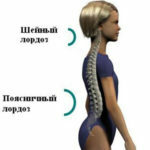 How the body behaves when it is struck by lordosis of the lumbar spine. Symptoms and treatment of the disease.
How the body behaves when it is struck by lordosis of the lumbar spine. Symptoms and treatment of the disease.
What causes inflammation of the joints of the big toes and what is the health risk, if the disease is allowed to run its course.
How is the disease
Spondylolisthesis of the lumbar spine has such symptoms:
- pain in the lumbar region;
- gradual spread of pain to buttocks and perineum;
- hip joint problems;
- when jamming the nerve endings - there may be a violation of the sensitivity of the skin;
- increased urination.
But unfortunately, these symptoms are present in other diseases of the spine.
Diagnosis
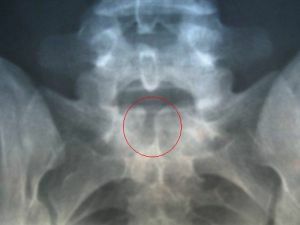 Diagnosis of the disease occurs in several stages. The first stage involves talking or interviewing the patient by the treating doctor.
Diagnosis of the disease occurs in several stages. The first stage involves talking or interviewing the patient by the treating doctor.
In the second stage, the doctor examines the patient to determine the pain zones, the work of nerve endings, the state of muscle mass. And also, during the examination there is a study of pain syndrome - its increase when performing simple actions.
The third stage is the patient's referral to X-rays and, if possible, MRI.These examinations give a "picture" of the condition of the spine and the need for its treatment or simple prevention.
Treatment of the disease - tasks and procedures
We designate the goals and objectives for the treatment of lumbar spine and cervical spondylolisthesis.
Aims and objectives of
The main goal of all the treatment methods used in this disease is to restore the spine functions in full.
In connection with the purpose of treatment, as well as the course of the disease, the following tasks are indicated:
- withdrawal of pain syndrome;
- restoration of spinal flexibility;
- reinforcement of reconstituted fabrics;
- splicing of fractures, if any;
- prevention of recurrence of the disease.
In medicine today there are several approaches to the treatment of this disease:
- conservative methods;
- restorative therapy;
- by medicamentous treatment;
- by surgical intervention.
So, for example, to conduct recovery therapy, you need a referral to a rehabilitation doctor. Correctly formulated treatment program helps to reduce pain, inflammation, restore flexibility and mobility of the ridge.
Medication is prescribed in rare cases and only to relieve serious pain.
Conservative methods
In order to avoid surgical intervention doctors often prescribe rest excluding physical activities of , in addition - wearing a special corset 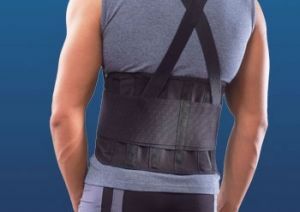 to relieve pain and accelerate the proper splicing of tissues.
to relieve pain and accelerate the proper splicing of tissues.
Addition to conservative treatment may be the above mentioned therapy and drug treatment.
Surgery
Any surgery involves an intervention in the life of the body, is quite dangerous for the patient's life and therefore is used extremely rarely.
Since any operation on the spine is not safe because of the spinal cord passing through here - this method is used in very rare cases.
Complications of
Complications can occur as a result of constant sports activities, injury and damage.
In addition, spondylolysis spondylolisthesis can gradually develop from this disease - deformation of the spine.
And it is in this case that the only and necessary solution will be surgical intervention.
Preventive measures
To avoid recurrence of this disease and its prevention, the following rules should be observed:
- to limit the load on the spine;
- to take medications that interfere with inflammatory processes;
- take drugs to improve blood circulation.

